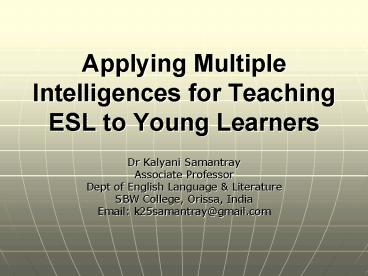Applying Multiple Intelligences for Teaching ESL to Young Learners - PowerPoint PPT Presentation
1 / 46
Title:
Applying Multiple Intelligences for Teaching ESL to Young Learners
Description:
Helps to identify basic personal characteristics, traits, ... Trivia quizzes. Stories. Speaking, listening and seeing words. Reading, writing and stories ... – PowerPoint PPT presentation
Number of Views:2623
Avg rating:3.0/5.0
Title: Applying Multiple Intelligences for Teaching ESL to Young Learners
1
Applying Multiple Intelligences for Teaching ESL
to Young Learners
- Dr Kalyani Samantray
- Associate Professor
- Dept of English Language Literature
- SBW College, Orissa, India
- Email k25samantray_at_gmail.com
2
The concept of MI
- Gardner's Multiple Intelligences theory (1983)
- Helps to identify basic personal characteristics,
traits, behaviors, and preferences for each of
the nine intelligences
3
The concept of MI
- One form of intelligence is not better than
another. - Some intelligences are better developed in
individuals than the others. - Each intelligence is equally valuable and viable.
4
MI in the Indian Context
- No foothold in early childhood education in India
- Two very powerful applications
- i. potential for helping more students succeed
by keeping them motivated to learn - ii. can offer a continual process of teacher
development
5
Assumptions underlying this project
- Teachers have to, first, identify their own
strengths and intelligences which are less
developed - To be aware of the unconscious teaching biases
6
Assumptions
- Teachers may begin to notice
- patterns and correlations between the strengths
they employ - the approaches they are less comfortable with,
and therefore, dont use.
7
Assumptions
- When they are aware, they may apply input in
different intelligence modes to provide a
holistic approach to teaching ESL. - Eight/ more approaches to teaching any topic to
lesson planning
8
Questions raised to be investigated
- Are the learners' strengths the same as the
teachers? - Do learners use intelligences that are different
from the ones their teachers use?
9
Questions raised to be investigated
- Will trs notice that they were unaware of / have
avoided using the teaching strategies - best designed for
- developing all the different
- intelligences in learners?
10
The Project
- Three primary schools in Bhubaneswar
- were taken up for a three-month small
- scale project to experiment with the
- MI principles.
- No. of Trs 9
- No. of Ss 303025 85
- Level Class 5
11
ProcedureStage 1
- Class observation
- Used the BC test trs analyzed their responses
to codify their strengths - Interviewed teachers
12
Testing Ss for their MI
- Randomly chosen sample took the BC
- test
- Most developed intelligences
- Kinesthetic, Musical, Naturalistic, Visual-Spatial
13
Outcomes of Stage 1
- Strengths found out by trs
- linguistic, logical/mathematical,
- musical
- Teachers were quite surprised to see their test
results matching with the class observation
results.
14
- Trs were more surprised to see
- the test results for their Ss.
- Some acceptance of multiple pathways to ESL
learning
15
Stage 2
- Lesson planning using
- eight intelligences
16
Classroom implementation
- Creating eight different work centers related
to the eight MI pathways not possible - Walls were used to show eight spaces each
dedicated to one of Gardner's eight intelligences
17
Linking learners to activity types
18
Linking learners to activity types
19
Linking learners to activity types
20
A sample lesson plan
- Activity center constructed a three layer
replica of earth - Math center worked with geometric concepts
- Reading center read a story The Magic School Bus
21
LP continued
- Music Center
- listened to poems related to earth, used rhythm
- learned the syllabic structure of words using
beats
22
LP continued
- Art center cut out concentric
- circles of different sizes, coloured, pasted
labelled them to - identify the different zones
23
LP continued
- Working together prepared a fact sheet on earth
jointly answered questions
24
Changes perceived
- Acceptance of different intelligences
- Some change in the earlier teacher attitude
towards the pathways to input - Marked change in learner attitude
25
- Trs focused on development of the
- intelligences that are traditionally
- neglected,
- such as musical, kinesthetic and naturalistic
26
Assessment of ESL learning
- a chart with names of students and the name of
each activity - Used a color code
- - green for competence (46)
- - yellow for working on (nearly 100)
- - red for underachievement (8)
27
Problems in implementing MI
- Teacher reluctance No incentive for innovation
- Administrators focused on short-term gains and
test results - Parents not seeing the value of an MI approach
28
Looking ahead
- Extensive awareness
- A supportive curriculum
29
Conclusion
- Applying MI can forestall
- cognitive narrowing
- of the learners.
30
(No Transcript)
31
Two more Intelligences
- Naturalistic Adventure Centre
- Existential not used
32
Different pathways for input
- Nurturing and teaching children and honoring
their individual needs and strengths
33
(No Transcript)
34
(No Transcript)
35
(No Transcript)
36
(No Transcript)
37
(No Transcript)
38
(No Transcript)
39
(No Transcript)
40
(No Transcript)
41
A continual TD
- We should reflect upon and identify our own
strengths and intelligences which are less
developed because we naturally rely on and use
teaching strategies that match our strongest
intelligences.
42
TD
- Identify the strengths and
- "lows" of the learners.
- Apply input in different
- intelligence modes.
43
Issues investigated
- Are the learners' strengths the same as the
teachers? - Do the strengths enjoyed by the teachers create
unconscious teaching biases?
44
The project
- Tr awareness on the three issues
- raised
- Lesson planning for the 8 intelligence
- types
45
Outcomes
- More involvement by trs lrs
- Marked change in learner attitude
46
Some problems
- Attitudinal problems
- More training post-training support reqd
- Extra resources































